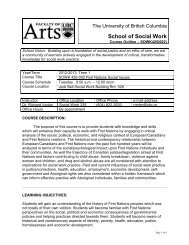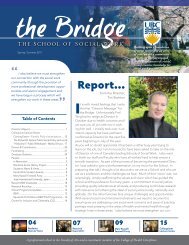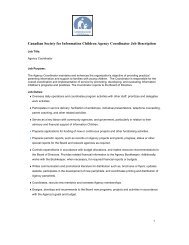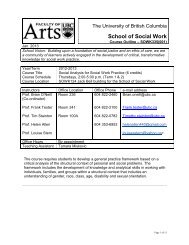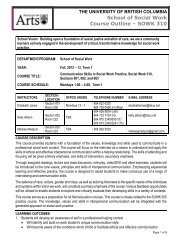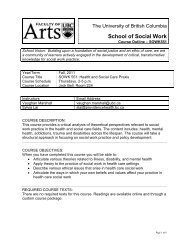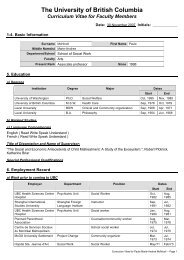Equity Case Studies Report - School of Social Work - University of ...
Equity Case Studies Report - School of Social Work - University of ...
Equity Case Studies Report - School of Social Work - University of ...
You also want an ePaper? Increase the reach of your titles
YUMPU automatically turns print PDFs into web optimized ePapers that Google loves.
UBC school <strong>of</strong> social work equity and diversity strategic plan: A compilation <strong>of</strong> case studies 6<br />
PART ONE: INDIVIDUAL CASE STUDIES<br />
DALHOUSIE UNIVERSITY<br />
Background Information on Educational <strong>Equity</strong> at the <strong>School</strong> <strong>of</strong> <strong>Social</strong> <strong>Work</strong><br />
The <strong>School</strong> <strong>of</strong> <strong>Social</strong> <strong>Work</strong> at Dalhousie <strong>University</strong>, originally called Maritime <strong>School</strong> <strong>of</strong><br />
<strong>Social</strong> <strong>Work</strong>, was established in 1941. The <strong>School</strong> <strong>of</strong>fers Bachelor <strong>of</strong> <strong>Social</strong> <strong>Work</strong> and Master <strong>of</strong><br />
<strong>Social</strong> <strong>Work</strong> programs. Since 2000 they have <strong>of</strong>fered these programs through Distance<br />
Education. The <strong>School</strong> currently has three pr<strong>of</strong>essors, four associate pr<strong>of</strong>essors, five assistant<br />
pr<strong>of</strong>essors, twelve adjunct pr<strong>of</strong>essors, and eleven staff members (Dalhousie <strong>University</strong>, Faculty<br />
<strong>of</strong> Health Pr<strong>of</strong>essions, <strong>School</strong> <strong>of</strong> <strong>Social</strong> <strong>Work</strong>, 2011). (See Appendix A for faculty members’<br />
areas <strong>of</strong> research.)<br />
Dalhousie <strong>University</strong>’s <strong>School</strong> <strong>of</strong> <strong>Social</strong> <strong>Work</strong> began to address equity and diversity<br />
since the early 1970’s 1 . At this time, there were a few faculty members, including the Director<br />
<strong>of</strong> the <strong>School</strong> (Dorothy Moore), who were concerned that the <strong>School</strong> was made up <strong>of</strong> only<br />
Caucasian faculty, staff, and students, which did not represent all racial and ethnic diversity<br />
present in the province. They posed the question, “Who’s not represented, and why?” and were<br />
dedicated to seeking change in the <strong>School</strong> <strong>of</strong> <strong>Social</strong> <strong>Work</strong>. The equity-seeking groups 2 targeted<br />
at this time included persons identifying as Mi’kmaq, African Nova Scotian, or Acadian. These<br />
equity-seeking groups were chosen based on provincial demographics and the identification <strong>of</strong><br />
racially minoritized and marginalized groups. The initial focus was on student admissions,<br />
1 In addition to other printed and online references, this case study was compiled with information from an interview<br />
2 “<strong>Equity</strong>-seeking groups” will be used throughout this case study to represent “minority”, “minoritized”, or<br />
“marginalized” groups, as to stay consistent with the language used by the interviewee.



